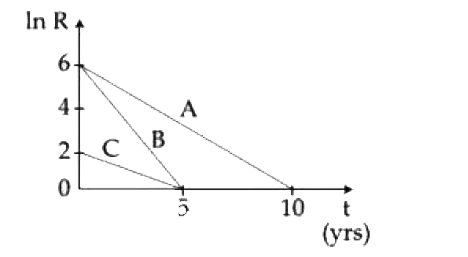Assume that two radioactive substances A and B disintegrate as:
−d[A]dt=kA,t1/2(A)=0.693KA
−d[B]dt=kB[B]2,t1/2(B)=1kB[B]0
If both the half life periods and initial concentrations are equal, what will be the ratio of the rates of the two substances at the start of the reaction?
Video Solution
Text Solution
According to available data, t1/2(A)=t1/2(B)
0.693kA=1kB[B]0 or kAkB=0.693[B]0=0.693[A]0
At the start of the reaction
rA=kA[A]0, rB=kB[B]20=kB[A]20 ……......[∴[A]0=[B]0]
∴rArB=kA[A]0kB[A]20 or rArB=0.693[A]0×[A]0[A]02=0.693
|
Updated on:21/07/2023
Related Playlists
- BOOK - DINESH PUBLICATIONCHAPTER - CHEMICAL KINETICSEXERCISE - NCERT Exercise1videos
CHEMICAL KINETICS
- BOOK - DINESH PUBLICATIONCHAPTER - CHEMICAL KINETICSEXERCISE - NCERT in text questions38videos
CHEMICAL KINETICS
- BOOK - DINESH PUBLICATIONCHAPTER - CHEMICAL BONDING AND MOLECULAR STRUCTUREEXERCISE - Unit Test - 120videos
CHEMICAL BONDING AND MOLECULAR STRUCTURE
- BOOK - DINESH PUBLICATIONCHAPTER - CHEMICAL THERMODYNAMICS AND CHEMICAL ENERGETICS EXERCISE - Exercise507videos
CHEMICAL THERMODYNAMICS AND CHEMICAL ENERGETICS
Similar Practice Problems
- Question 1 - Select One
For the reaction 2A→B+3C, if −d[A]dt=k1[A]2,−d[B]dt=k2[A]2,−d[C]dt=k3[A]2 the correct reaction between k1,k2 and k3 is :
Ak1=k2=k3B2k1=k2=3k2C4k1=k2=3k2Dk12=k2=k33 - Question 1 - Select One
For a reaction, A+2B→C, rate is given by +d[C]dt=k[A][B], hence, the order of the reaction is
A1B2C1D0 - Question 1 - Select One
3A→2B, rate of reaction +d[B]dt is equal to:
A−32d[A]dtB−23d[A]dtC−13d[A]dtD+2d[A]dt - Question 1 - Select One
In the reaction 3A→2B, rate of reaction +d[B]dt is equal to :
A−32d[A]dtB−23d[A]dtC−13d[A]dtD+2d[A]dt - Question 1 - Select One or More
For the reaction AK1⇐===⇒K2B, if 'a' is the initial concentration of A and n is the number of moles of A reacting if initially no B was present then :
Adxdt=[K1(a−x)−K2x] initiallyBK1(a−xe)−K2xe=0 at equilibriumCK1+K2=K1.axeD(K1+K2)=1tln.xexe−x - Question 1 - Select One
The rate and mechanism of chemical reactions are studied in chemical kinetics. The elementary reactions are single step reactions having no mechanism. The order of reaction and molecularity are same for elementary reactions. The rate of forward reaction aA+bB→cC+dD is given as :
rate = =(dxdt)=−1ad[A]dt=−1bd[B]dt=1cd[C]dt=1dd[D]dt or rate =K[A]a[B]b. In case of reversible reactions net rate expression can be written as : rate =K1[A]a[B]b–K2[C]c[D]d. At equilibrium, rate = 0. The constants K,K1,K2, are rate constants of respective reaction. In case of reactions governed by two or more steps reactions mechanism, the rate is given by the solwest step of mechanism.
For the reaction : aA→bB,
log[−dAdt]=log[dBdt]+0.6, then a:b is :A3.98B2.18C1.48D0 - Question 1 - Select One or More
For the reaction A B, the rate law expression is −d[A]dt=k[A]1/2. If initial concentration of [A] is [A]0, then
AThe integerated rate expression is k=2t(A1/20−A1/2)BThe graph of √A Vs t will be
 CThe half life period t1/2=K2[A]1/20DThe time taken for 75% completion of reaction t3/4=√A0k
CThe half life period t1/2=K2[A]1/20DThe time taken for 75% completion of reaction t3/4=√A0k
Similar Questions
The rate law equation for the reaction A→B is found to be −d[A]dt=k[A]1/2
If [A]0 were the initial concentration of A, derive expressions for
(i) rate constant in the integrated form (ii) half-life period of the reactionView SolutionThe rate of change of concentration of (A) for reaction A→B is given by
−d[A]dt=k[A]1/3
Derive expression for half-life period of the reaction.View SolutionActivities of three radioactive substances A, B and C are represented by the curves A, B and C, in the figure. Then their half- lives T12(A):T12(B):T12(C) are in the ratio :
 View Solution
View Solution

